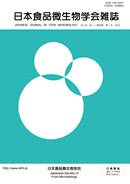Volume 35, Issue 3
Displaying 1-12 of 12 articles from this issue
- |<
- <
- 1
- >
- >|
Review
-
2018 Volume 35 Issue 3 Pages 105-111
Published: September 30, 2018
Released on J-STAGE: October 06, 2018
Download PDF (972K)
Symposium I: Secure Safety in Food Environment
-
2018 Volume 35 Issue 3 Pages 112
Published: September 30, 2018
Released on J-STAGE: October 06, 2018
Download PDF (160K) -
2018 Volume 35 Issue 3 Pages 113-115
Published: September 30, 2018
Released on J-STAGE: October 06, 2018
Download PDF (407K) -
2018 Volume 35 Issue 3 Pages 116-121
Published: September 30, 2018
Released on J-STAGE: October 06, 2018
Download PDF (766K) -
2018 Volume 35 Issue 3 Pages 122-126
Published: September 30, 2018
Released on J-STAGE: October 06, 2018
Download PDF (598K)
Originals
-
Evaluation of PCR Screening for Campylobacter Food Poisoning Based on Epidemiological Investigations2018 Volume 35 Issue 3 Pages 127-133
Published: September 30, 2018
Released on J-STAGE: October 06, 2018
Download PDF (397K) -
2018 Volume 35 Issue 3 Pages 134-142
Published: September 30, 2018
Released on J-STAGE: October 06, 2018
Download PDF (442K) -
2018 Volume 35 Issue 3 Pages 143-148
Published: September 30, 2018
Released on J-STAGE: October 06, 2018
Download PDF (565K)
Epidemiologies
-
2018 Volume 35 Issue 3 Pages 149-153
Published: September 30, 2018
Released on J-STAGE: October 06, 2018
Download PDF (619K) -
2018 Volume 35 Issue 3 Pages 154-158
Published: September 30, 2018
Released on J-STAGE: October 06, 2018
Download PDF (350K)
Case
-
2018 Volume 35 Issue 3 Pages 159-162
Published: September 30, 2018
Released on J-STAGE: October 06, 2018
Download PDF (354K)
Book Review
-
2018 Volume 35 Issue 3 Pages 163
Published: September 30, 2018
Released on J-STAGE: October 06, 2018
Download PDF (153K)
- |<
- <
- 1
- >
- >|
